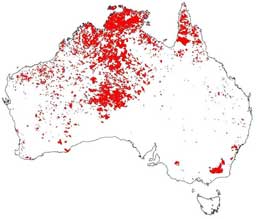The north-south divide
Although, fire occurs in biomes throughout Australia, there is a clear north-south divide in terms not only of how vegetation is able to survive and tolerate fires, but also in terms of differences in fire regimes, and the way fire is viewed by people living on the land.
Northern Australia has a much lower, more sparsely distributed population, a relatively intact natural environment and a larger Indigenous population than southern Australia. Fire is more widespread and frequent in northern Australia than in any other part of the continent. On average 1/5 of the northern savannas is burnt each year, although this may be higher in a given year. Most of the fires are deliberately lit by people for natural resource management purposes.
Burn area of tropical savannas |
|
|---|---|
| Area of tropical savannas: | 1,920,372 sq.km |
| Mean area burnt 1997-2004: | 357,188 sq.km (22%) |
| Area of NT tropical savannas: | 636,239 sq.km |
| Mean area burnt 1997-2004: | 180,874 sq.km (28%) |
| Area of QLD tropical savannas: | 971,544 sq.km |
| Mean area burnt 1997-2004: | 79,023 sq.km (8%) |
| Area of WA tropical savannas: | 324,283 sq.km |
| Mean area burnt 1997-2004: | 97,290 sq.km (30%) |
Activity: Fire across Australia
Where does Australia burn?
Have a look at this map which illustrates the occurrence of fire across Australia for a typical fire year. Compare the area burnt in northern and southern Australia.
Fire Season 2002 - 2003 (Click for larger image)
Can you see the Canberra fires of 2003?
Importantly, in northern Australia fire is much more about landscape management and biodiversity conservation than about the protection of life and property.
In southern Australia, which is the most densely populated area of the country, the situation is quite different. Fire frequencies are much lower (10-60 years, rather than 1-5 years!), fires burn through the tree canopies, and concern is directed primarily to the protection of life and assets. A lot of fire operations centre on the rural/urban interface. There have been some large, fatal fires in the ‘south’ which will be explored later in the course.
